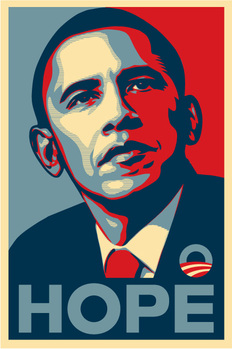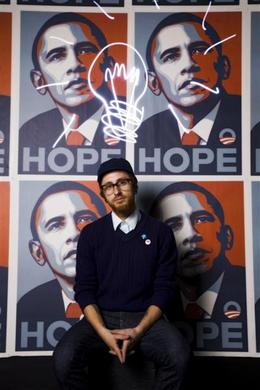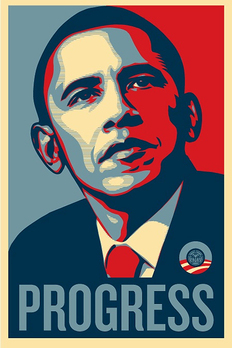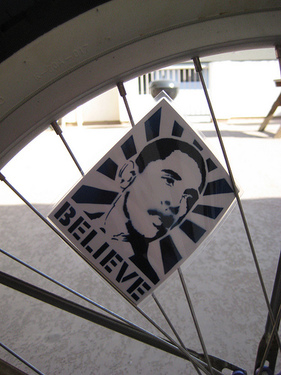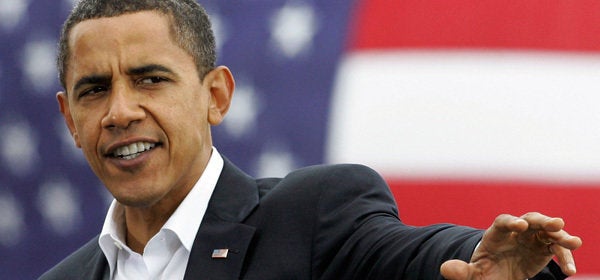
The large majority of people reading this post have seen this image before. This iconic image of Barack Obama, adorned on posters, stickers, clothing and more, was created by Los Angeles-based, contemporary street artist Shepard Fairey. This image has become a pop cultural phenomenon and an important symbol in the political landscape of 2008 and beyond. How did this image spread virally so quickly? Who was involved in making that happen?
A couple of days ago, I spoke with Shepard and Yosi Sergant, the marketing/publicity guru who helped link Fairey to the Obama campaign and who helped the image transcend from mere poster into a phenomenon. Here's a transcript of the interview:
Ben Arnon (BA): The first time I saw the "Hope" poster was at a GOTV (Get Out the Vote) rally I helped organize in South Los Angeles on February 2nd, 2008, which was the Saturday before Super Tuesday. I vividly remember a student volunteer from USC who stopped by the rally and handed out tons of posters. The next thing I knew it had spread virally so quickly that it seemed to be everywhere within a matter of days.
Most of my questions will examine how and why this phenomenon caught on so quickly and, in the vein of Malcolm Gladwell's The Tipping Point, who were the Connectors and Mavens who helped fan the flames of this viral phenomenon?
My first question is simply how did the idea begin and at what point did you, Shepard, and Yosi begin working together?
Shepard Fairey (SF): I met Yosi a couple of times in the past but the time we spoke about Obama was at an Adidas event at the end of October 2007. Interestingly enough, we talked about Obama and I said "Yeah, I dig Obama, he'll probably get crushed by the Clinton juggernaut but I dig him." Yosi was not as much of a pessimist as I was and he said it would be cool if I did something for [Obama]. Yosi thought we could figure something out. I said I'd love to but in my past as an artist, I've always worked as an outsider and I've always decided not to go through the bureaucracy. My philosophy is usually if I want to make things happen I'll just act first and apologize later.
But with this I actually knew that Obama's support was probably going to be people who are fairly progressive and an endorsement from someone like me might not actually be a welcome endorsement if it made Obama seem like the fringe, street-artist, radical types were his supporters. I really wanted to help and I didn't want to be that unwelcome endorsement or affiliation.
So I talked to Yosi about it and he reached out to some people he knew. Interestingly, Hill Harper came to my art show in LA at the beginning of December -- just about a month after Yosi and I spoke. Just by the nature of my work and the topics in my artwork, Hill asked me who I was supporting. I said Obama and I mentioned to Hill the same desire to do a poster. Hill said he knew Obama personally and he would look into it as well.
I didn't want to act without permission and have it be seen as undermining Obama's goals in any way. Then Yosi finally got the go-ahead about two weeks before Super Tuesday for me to do an image. I looked for an image that I thought was a good image, illustrated it in one day and had the posters in production the next day. I sent the final over to Yosi who said "Looks great, let's roll with it." I had screen-printed posters printed immediately, sold 350 and put another 350 up on the street. We used the money from selling the 350 to then print up another 4,000 posters that are the ones we gave out at those rallies you mentioned.
It also went viral. As soon as I posted it on my web site a lot of people that go to my web site saw it. Yosi also blasted it out to a lot of his contacts. It became very clear quickly that the demand for an image like that had not been supplied and that the Obama supporters were very hungry for it and also very motivated to spread it.
I think what then happened was that there were a lot of people who were digging Obama but they didn't have any way to symbolically show their support. Once there was an image that represented their support for Obama then that became their Facebook image or their email signature or something they use on their MySpace page. Or they printed out the image and made their own little sign that they taped up in their office. Once that exists it starts to perpetuate and it replicates itself.
I think a perfect pop culture example of something like that is the Rolling Stones tongue logo. The tongue was a secondary logo on the back of the Sticky Fingers album, but it was iconic and simple. Now it's sort of undisputed as the Rolling Stones logo even though it was never created intentionally to be that. It found an audience and it manifested.
Yosi and I did a show in Denver during the DNC Convention called Manifest Hope and I think [the "Hope" poster image] was symbolic of a lot of things including Hope and it just manifested.
Shepard Fairey -- The Artist
Yosi Sergant -- The Publicist
BA: Tell me more about that initial run of 350 posters.
SF: Well, the way I'm used to doing things when I print up posters is I print some to sell and I print some to put up on the street. I fund the ones I put up on the street with the ones I sell. That way the whole thing is paid for and I'm perpetuating things on my own terms. I did that to get the ball rolling and then I was going to use the revenue from the first 350 posters to get more printed for a full statewide campaign. At first I was just thinking California because there was such a short amount of time left until Super Tuesday. But so quickly we saw that the demand was there so we started shipping the posters all over the country anywhere that hadn't had a caucus or a primary yet.
BA: Those initial posters -- the 350 to sell and 350 for the streets, along with the 4,000 you sent around to rallies -- did they all read "Progress" or were they a combination of "Progress" and "Hope"?
SF: The first 350 that went up on the street and those 350 that we sold all said "Progress". Then Yosi got feedback from the campaign saying they wanted to push the "Hope" message so I switched it to "Hope" for the next ones.
BA: With those first 350 that were sold, you were essentially seeding these posters with what Malcolm Gladwell would call the Connectors and Mavens. Who were these people? Also, did you sell all of these prints online or did you sell some on the streets?
SF: I sold them all through my web site which gets a lot of traffic. I figured I'm making this image to influence my audience but then also take the revenue to spread this stuff further. But the first step was getting it out to my audience. This is how naive I was at the time about Obama's popularity. I actually lowered the price on the print thinking that a lot of people might be pessimistic about Obama's chances and it might not sell well. And I included my Obey star embedded in the Obama logo, not to try to highjack Obama's credibility as some people have said. But rather, because I know that my hard-core collectors would feel that they had to buy the poster just because it had an Obey logo. Therefore, I was more or less forcing my audience to fund further perpetuation of the image.
BA: Was the majority of your audience that bought the original print Los Angeles-based or nationwide?
SF: Definitely nationwide. I had no idea that it would happen but immediately after those prints were sold out they were selling for $2,000-$6,000 on the Internet.
BA: Yes, that was one of the incredible things about this image that stood out to me. I saw the posters originally on Saturday, February 2nd. The following day I helped organize volunteers at a big rally at UCLA that featured Michelle Obama, Oprah Winfrey, Caroline Kennedy and others. And there were posters passed out there.
SF: The posters at that UCLA rally was all Yosi. I was in the hospital with my wife who was about to have a baby.
Yosi Sergant (YS): I was running up and down the aisles rolling up posters and sticking them in the hands of people in the bleachers who would be in the camera shot.
BA: Yes, I clearly remember that. Then, within a matter of days, I was hearing about these prints selling on eBay for thousands of dollars. And friends of mine working on the campaign throughout the entire country had these posters already. There are literally companies with large distribution budgets that cannot achieve nationwide coverage as quickly as your posters did. It spread so quickly and so virally. Was all of your distribution online or was there an infrastructure set up on the ground? I read on Wikipedia that you have an informal network of collaborators who replicate your designs. Is that one of the ways you managed to achieve such widespread distribution in such a short period of time?
SF: That's actually not even true. I've read that I have street teams throughout the country to put up my posters. But that is actually not true at all. However, there are a lot of people who are really excited about Obama and it's unique. It's something that people are willing to take the risk to do -- to go out to put some posters on the streets. We sent posters to Philadelphia and they got put up all over -- on abandoned buildings and on street corners. That's something you don't normally see - that level of motivation in people to spread an image. There are a lot of graffiti artists who are motivated enough to spread their own work and their own name - I'm one of them -- but this is that unique case where all we had to do was make the materials and disseminate them to some sort of hubs around the country and the rest of it pretty much took care of itself.
YS: The one thing we have no shortage of is motivated people who want the poster and who want to spread it far and wide.
SF: Yeah, there are store owners who want to put it in their window, people who put it in the window of their homes, people who are willing to go out and post it up. People will put it on a piece of cardboard and put it on a stake in their front yard. It's pretty amazing and I think all we did was we put it into some of the right channels so that the people who had that willingness could get a hold of them.
BA: These hubs you describe throughout the country -- were they mainly street artists and Obama supporters or were they also coordinated through any official Obama campaign staff organizers?
YS: For example in Philadelphia, the main hub center was a gentleman named Tayyib Smith who has a magazine called 215. There are people in every city who are much like Shep and myself. They have large networks around them, and as you mentioned earlier about Malcolm Gladwell, these people are the influencers in each town. There is a vast network of people who talk to each other on the regular from city to city. We track events we've all done and we look at who's doing good work in each town. We all pay attention to each other and we know each other's reach and capabilities. To find out who would be the right hub or distribution point in each city is literally two Google clicks away.
SF: The main thing was that we just needed to keep producing the posters because the demand was high. You know, unfortunately the Internet is both good and bad. It's good because a lot of people have access to information very quickly. It's bad in that a lot of the information is bogus. For instance, I had already read rumors that I was profiting big-time off of the Obama image. Even though that wasn't valid, I was very cautious not to do anything that would even vaguely validate that argument. So I actually ended up selling a lot of fine art commissions of the Obama image to private collectors and using that money to print more posters rather than continuing to sell the posters. We've sold less than 2,000 posters and have printed over 200,000 of them. And we've printed 500,000 stickers.
We did the same thing with the stickers. We worked with a friend of mine who is a sticker printer and who is an Obama supporter. He sold sticker packs and used all of the profits from the sticker packs to keep printing more stickers. It was a really beautiful thing the way it all worked. People who could afford stickers bought them and for the people who couldn't afford them, we just gave the stickers to them.
BA: I've seen the posters and the stickers but I've never seen bicycle spoke cards though I have read that they exist. Were the bike spoke cards only distributed in certain cities? Also, has the image taken any other form besides posters, stickers, and bike spoke cards?
SF: We did t-shirts through my clothing line as well as through Upper Playground. They've been really helpful at perpetuating the image. They printed up some shirts and sweatshirts and donated those to us to give out. They sold others and put the money back into making more stuff. When we did bus stop ads in Philadelphia, that was paid for with t-shirt money. And Obey Clothing has done t-shirts too that have been sold at retailers and once again, that money has gone back into making more posters and doing events like what we did at the DNC -- the Manifest Hope art show -- and we're working on some other things as well.
YS: The bicycle spoke cards were supported and funded by the profits of Shepard's work. But we reached out to an artist named Mags, from New Orleans, who was displaced by Hurricane Katrina. She has been making beautiful artwork on behalf of Barack Obama for a long time. And we turned that business into exactly the same thing. We sold bike spoke cards for a buck a piece and then used the profits to pay for the production. We ended up making 20,000 bike spokes that we distributed for free throughout Oregon before their Primary.
BA: What are your plans for the final weeks of the campaign?
SF: We're really trying to get people to get out and vote. I actually just did another illustration for the Obama campaign directly that is a portrait of Barack smiling and looking very human and also very dignified and Presidential. The message on that image is simply VOTE. Yesterday we did some viral video spots with a bunch of musicians and celebrities that were pieces to encourage people to support Obama but also just to get out there and vote.
I'm also going to Washington, DC and Boston this month. I have legal walls in both cities already reserved where I'm going to do murals that contain the Obama imagery. And I'll do my thing on the street also.
That's the story about how one image transcended from mere poster into a cultural phenomenon and an important, iconic symbol of Barack Obama's Presidential campaign.
Please leave comments. Tell us what the image symbolizes to you. Also, tell us your story about the first time you saw this iconic image.
To buy shirts, go to: http://bit.ly/3rzC2E
To buy stickers, go to: http://www.stickerobot.com/obama

